| Author |
Message |
|
Christopher Lee
Location: Sunshine Coast, Australia Joined: 18 Apr 2006
Posts: 160
|
 Posted: Mon 13 Aug, 2007 5:44 pm Post subject: Talhoffer's pollaxes Posted: Mon 13 Aug, 2007 5:44 pm Post subject: Talhoffer's pollaxes |
 |
|
Hi,
I'm curious to know if there are any surviving examples of pollaxes similar to those depicted in Talhoffer? I've looked through the pollaxe article and historical weapons album but there is nothing that quite matches.
I've included some pics of the pollaxe heads that i'm particularly interested in from the mark rector talhoffer. There are a wide range of rather exotic pollaxe and polearm designs in talhoffer, some seemingly less plausible than others.
Is it likely that the pollaxe depicted in talhoffer was an actual historical weapon know to the illustrator or was it "artistic license" and not meant to represent any particular weapon, but a "generic" pollaxe? Is it possible that the style of pollaxe depicted was reserved for judicial combat or dueling; a specialised item only used for a specific purpose, like the dueling shields?
Does the pollaxe depicted in talhoffer appear to be a practical and effective weapon? If it was likely to be a historical weapon would anyone care to attempt a plausible graphic reconstruction (i'm somewhat graphically challenged)?
Christopher
 Attachment: 82.83 KB Attachment: 82.83 KB
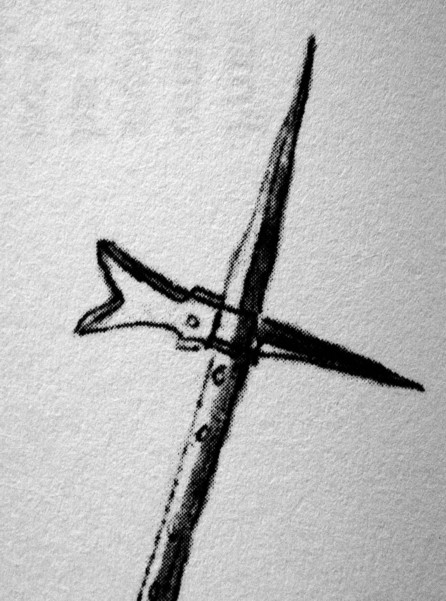
 Attachment: 55.08 KB Attachment: 55.08 KB
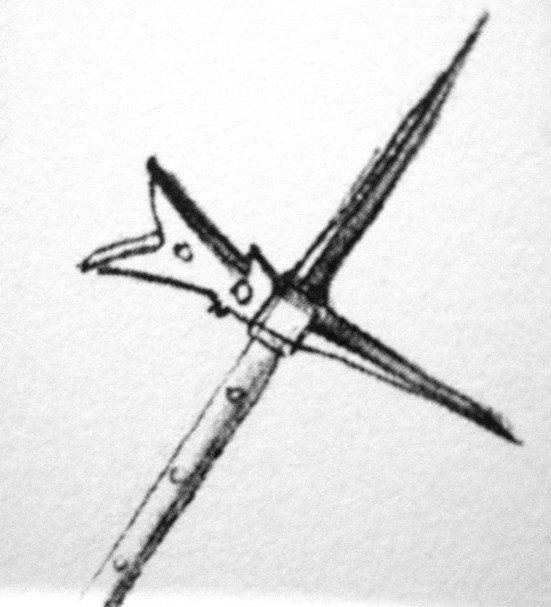
 Attachment: 52.13 KB Attachment: 52.13 KB
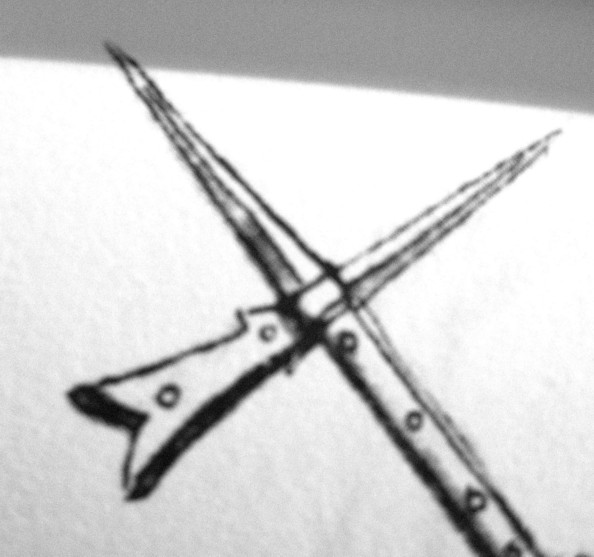
|
|
  |
 |
Shawn Henthorn

|
|
  |
 |
|
Hugh Knight
|
 Posted: Tue 14 Aug, 2007 12:23 am Post subject: Posted: Tue 14 Aug, 2007 12:23 am Post subject: |
 |
|
Ha! The Pollaxe--my favorite. Very good topic.
I've never seen an extant pollaxe anywhere that exactly matches the ones in Talhoffer 1467, but there are some that come pretty close, such as the two on the far right in this picture:
http://www.myArmoury.com/view.html?features/p...eaxe18.jpg
Medieval art doesn't show too many, either, but then that's not surprising: Of the three rough categories of pollaxe (Axe+Hammer, Hammer+Spike, and Axe+Spike), the Hammer+Spike version is almost universal in the Fechtbücher but the Axe+Hammer is much more popular in the general art (and, I would argue, is used the same way as the Hammer+Spike version anyway, but that's another topic).
Still, it's very clear that the major Fechtbuch sources (except Codex 11093 and Mair) universally refer to (even when they don't show) the Hammer+Spike version (and that they called it an "axe" in spite of the fact that it didn't have an axe blade: Le Jeu de La Hache refers to it as a "Hache" and Talhoffer refers to it as an "Axt" or "Streitaxt"). That, in turn, answers your question about their functionality: They were *very* functional, and it could be argued that the pollaxe was the premier knightly weapon of the 15th century for foot combat. I focus on pollaxe combat in my Schule and I can tell you the techniques are effective and elegant.
What are you trying to figure out?
Regards,
Hugh
www.schlachtschule.org
|
|
    |
 |
|
Nicholas Zeman
|
 Posted: Tue 14 Aug, 2007 12:16 pm Post subject: Posted: Tue 14 Aug, 2007 12:16 pm Post subject: |
 |
|
|
Fiore also calls it the "azza" despite the fact that he only shows the hammer + spike version.
|
|
  |
 |
Chuck Russell

|
 Posted: Tue 14 Aug, 2007 1:46 pm Post subject: Posted: Tue 14 Aug, 2007 1:46 pm Post subject: |
 |
|
check this book to see if its in there:
The halberd and other European polearms, 1300-1650 (Historical arms series)
by George A Snook (Author)
# : 32 pages
# Publisher: Museum Restoration Service (1998)
# Language: English
# ISBN-10: 0919316387
# ISBN-13: 978-0919316386
i have a bec de corbin for my 15thc reenactment. love it. its a wicked tool!
|
|
    |
 |
|
Mike West
|
|
  |
 |
Chad Arnow
myArmoury Team


|
 Posted: Tue 14 Aug, 2007 2:13 pm Post subject: Re: Please don't forget this link. Posted: Tue 14 Aug, 2007 2:13 pm Post subject: Re: Please don't forget this link. |
 |
|
Amazon has a copy for $8.95. It's worth picking up.

ChadA
http://chadarnow.com/
|
|
    |
 |
Sean Belair
Industry Professional

|
 Posted: Tue 14 Aug, 2007 3:27 pm Post subject: Posted: Tue 14 Aug, 2007 3:27 pm Post subject: |
 |
|
many survive, i'll put up pictures of a few for you.
 Attachment: 10.32 KB Attachment: 10.32 KB
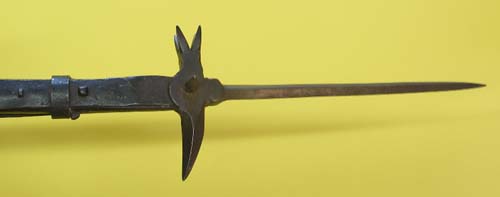
 Attachment: 23.06 KB Attachment: 23.06 KB

 Attachment: 68.67 KB Attachment: 68.67 KB
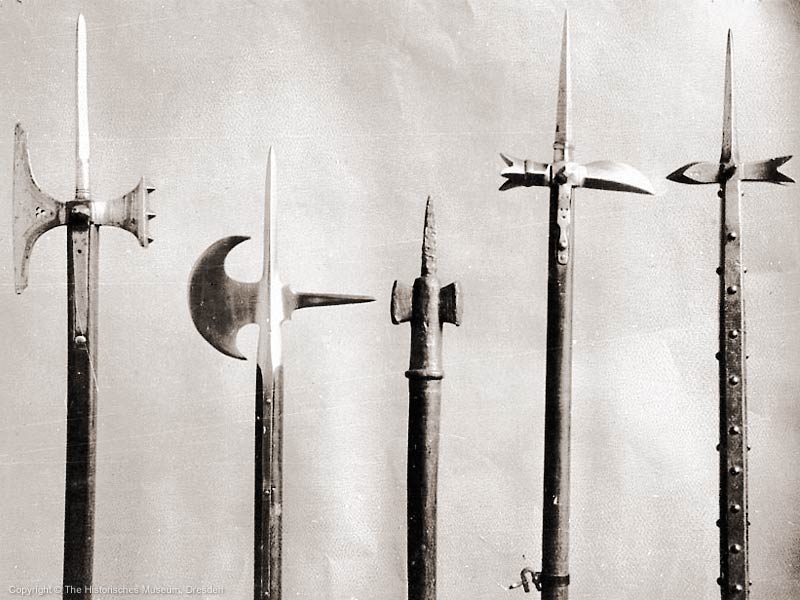
 Attachment: 8.84 KB Attachment: 8.84 KB
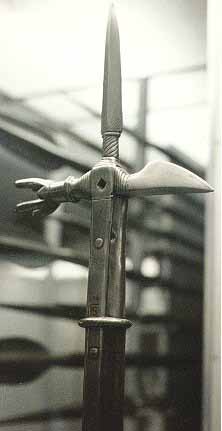
|
|
  |
 |
|
Mike West
|
 Posted: Tue 14 Aug, 2007 3:51 pm Post subject: Re: Please don't forget this link. Posted: Tue 14 Aug, 2007 3:51 pm Post subject: Re: Please don't forget this link. |
 |
|
Thanks, but that is from another sellor. It looks to be out of print. I did buy one several years ago from an amazon sellor for $10.00.
| Chad Arnow wrote: |
Amazon has a copy for $8.95. It's worth picking up. |
|
|
  |
 |
Chad Arnow
myArmoury Team


|
 Posted: Tue 14 Aug, 2007 4:13 pm Post subject: Re: Please don't forget this link. Posted: Tue 14 Aug, 2007 4:13 pm Post subject: Re: Please don't forget this link. |
 |
|
| Mike West wrote: | Thanks, but that is from another sellor. It looks to be out of print. I did buy one several years ago from an amazon sellor for $10.00.
|
I know it is.  I was just pointing out that it can still be found, cheaply and easily. I was just pointing out that it can still be found, cheaply and easily.
This website makes it seem like they are still available: http://www.manatarmsbooks.com/mrs.html

ChadA
http://chadarnow.com/
|
|
    |
 |
|
Mike West
|
 Posted: Tue 14 Aug, 2007 6:55 pm Post subject: So it is! Posted: Tue 14 Aug, 2007 6:55 pm Post subject: So it is! |
 |
|
Thanks. That is the first time I've seen the rest of the titles in that series. Some interestring stuff. It would be nice if they added some other types of weapons, such as medieval longswords, single handed swords, single edged swords, etc.
That book is a great indroduction to polearms. I purchased the John Waldman book, which is a much more in depth study
of polearms. It's about $139.00 currently, but I managed to see it for sale by one of amazon's sellors for $80. I'm glad I happenbd on that because I would have likely never paid the current price.
The book is called "Hafted Weapons in Medieval and Renaissance Europe." If your interested in polearms, I know of no other book that covers the topic in such depth.
|
|
  |
 |
|
Jeff Ross
Location: Apex, NC Joined: 30 Jul 2004
Posts: 33
|
 Posted: Tue 14 Aug, 2007 7:47 pm Post subject: Posted: Tue 14 Aug, 2007 7:47 pm Post subject: |
 |
|
Here's another surviving example, this one from the Keinbusch collection in Philadelphia:
Jeff
 Attachment: 46.35 KB Attachment: 46.35 KB
[ Download ]
|
|
  |
 |
Addison C. de Lisle

|
 Posted: Tue 14 Aug, 2007 8:31 pm Post subject: Posted: Tue 14 Aug, 2007 8:31 pm Post subject: |
 |
|
Out of curiosity, are there any decent modern makers for these?
www.addisondelisle.com
|
|
   |
 |
|
Mike West
|
 Posted: Tue 14 Aug, 2007 8:48 pm Post subject: Some ideas. Posted: Tue 14 Aug, 2007 8:48 pm Post subject: Some ideas. |
 |
|
| Addison C. de Lisle wrote: | | Out of curiosity, are there any decent modern makers for these? |
Arms and, Armor makes a poleaxe and, has made custom polearms. Del Tin used to make a Zurich (I think that's the style) Halbard and, I actually got to hold one once. There is also a nice review of a German Halbard on the review page, but I think it cost about $1500! A & A's custom pieces cost quite a bit as well.
I think Hank Reinhardt (who owned the halbard I got to handle) could better explain the economics of creating polearms, which might explain why they aren't found at decent prices. I would guess they aren't all that popular. COld Steel actually made a halbard, but only sold it for about a year.
I would love to see pole arms in the $300-$500 range. I'd start adding those to my collection.
|
|
  |
 |
|
Hugh Knight
|
 Posted: Tue 14 Aug, 2007 10:29 pm Post subject: Posted: Tue 14 Aug, 2007 10:29 pm Post subject: |
 |
|
| Addison C. de Lisle wrote: | | Out of curiosity, are there any decent modern makers for these? |
Unfortunately I don't know of anyone making a decent Hammer+Spike-style pollaxe; Arms & Armor used to, but they no longer list it in their catalog. Since this is the best type of axe for what I teach I'm having some made custom (although for day-to-day training we use the rubber axe heads from Revival mounted on rattan shafts).
I got my original steel pollaxe from a company in Czechoslovakia via Therion Arms, but they no longer carry them. There's a new company carrying a very similar one in Eastern Europe now, and they have one in stock, but I don't know what shipping would be like (go to the bottom of the page):
http://www.armabohemia.cz/Novestr/handA.htm
Museum Replicas also carries a pollaxe, but I really dislike it (ignore the nonsense about using the Bec de Faucon to punch armor), although it's certainly not grossly inauthentic:
http://www.museumreplicas.com/museumreplicas/detail.aspx?ID=80
Regards,
Hugh
www.schlachtschule.org
|
|
    |
 |
Randall Moffett

|
 Posted: Tue 14 Aug, 2007 10:55 pm Post subject: Posted: Tue 14 Aug, 2007 10:55 pm Post subject: |
 |
|
Hugh,
Why do you think the head is sperated into four on the Bec de corbins' usually? I have wondered about it for some time. It would seem a flat more hammer like head that some has would be more effective. I thought the reason the heads on jousts were seperated like this was to dissapate the energy? It would seem odd to do so with this weapon.
On a number of the pole axes I have looked at that are historic the langets are seperate slats that run under the head and the same rivits that connect the head to shaft pass through them. Does this seem to be the more common form of manufacture?
I got to work with one that was likely late 15th or 16th where I worked. Not sure if the haft was original as it was a good 7 feet or so long but the feel even with such a long shaft was that it could be a very quick and devestating weapon from just a few simple (and careful) manuvers with it. I still have pictures of it once it was cleaned and remounted.
RPM
|
|
  |
 |
|
Hugh Knight
|
 Posted: Wed 15 Aug, 2007 12:58 am Post subject: Posted: Wed 15 Aug, 2007 12:58 am Post subject: |
 |
|
| Randall Moffett wrote: | | Why do you think the head is sperated into four on the Bec de corbins' usually? I have wondered about it for some time. It would seem a flat more hammer like head that some has would be more effective. I thought the reason the heads on jousts were seperated like this was to dissapate the energy? It would seem odd to do so with this weapon. |
Hi Randall,
It's for the same reason that the coronel on a lance of peace was separated into prongs, but that wasn't, as you said, to dissipate the force: If the lance slides on plate the force is dissipated, but if it sticks all the force of the blow drives into the target (which makes it easier to break lances spectacularly in jousts of peace, and also keeps the lance from sliding along the plate to strike a relatively unarmored spot) and the prongs make it stick rather than slide. So the safety feature is more about keeping the lance head on a nice plate surface than it was about dissipating force--in fact, it acted to better concentrate the force. The prongs on a pollaxe were intended for exactly the same purpose: to keep the force concentrated by preventing sliding. The hammer on my steel axe has teeth (not the four prongs such as the ones to which you refer, but it's exactly the same principle). My armorer made a steel breastplate blank and we struck it with the hammer head and the teeth actually made little "bites" into the steel that held the axe head in place. It even felt more secure than a smoother head--we didn't feel even a tendency to slide.
| Quote: | | On a number of the pole axes I have looked at that are historic the langets are seperate slats that run under the head and the same rivits that connect the head to shaft pass through them. Does this seem to be the more common form of manufacture? |
I think this picture from Talhoffer's Alte Armatur und Ringkunst gives a pretty good idea of how most of the pieces were assembled in period:
http://base.kb.dk/pls/hsk_web/hsk_vis.side?p_...p_lang=eng
although I've never seen a screw-in Queue like that, nor a hint that they had interchangeable ones. Still, the head construction matches very closely with what I've seen.
The languets are separate strips that appear to go on first; I believe (but have never been able to be precisely sure) that the rivets that hold them on pass all the way through the shaft and are peened on the other side. On the other hand, my reproduction axe has nails that are staggered to hold the languets on but don't go all the way through, and this arrangement has worked well for several years of practice.
Then the head of the axe fits onto the top of the shaft, which is notched out to fit the head. The Dague is fit overall and holds the head proper onto the shaft. The Dague has two strips extending down to overlap the side languets by a bit. Finally, a nut (often pyramidal as this one is) and bolt assembly that passes through the side parts of the Dague and the head holds the entire head together.
Truthfully, however, I'll bet you've seen more of these than I have, at least up close.
| Quote: | | I got to work with one that was likely late 15th or 16th where I worked. Not sure if the haft was original as it was a good 7 feet or so long but the feel even with such a long shaft was that it could be a very quick and devestating weapon from just a few simple (and careful) manuvers with it. I still have pictures of it once it was cleaned and remounted. |
My sources (e.g., the late Bob Carrol, former armorer at the Met in NY) tell me that almost none of the shafts on pollaxes today are from the working life of the piece and that many were made longer than the original to match later perceptions of pole arm use. After all, many of the pole weapons intended for mass infantry use (e.g., halberds, bills, etc.) were often quite long due to the needs of melee combat, so I can see why pollaxes would be lumped in with them. The pollaxe, however, was more of an in-close weapon (although it could be "swung long" in melee) and making it too long renders it unweildy in the kind of close-in fighting the Fechtbücher show us.
A sixteenth-century author named Pietro Monte said that the shaft of a pollaxe should be "one hand" (four inches) taller than the man using it, and some sources seem to show about that length, while others show much, much shorter weapons. I'll attach a picture of an axe with its original shaft that's less than five feet in length, and I have pictures of men using shorter ones. I don't practice with axes that short because I believe that those described by the Fechtbücher were longer than this, but there's no denying it happened. In his book on Renaissance Martial Arts Anglo said that many sources recommended an axe about the length of the man using it, and I have found this to be a very good rule of thumb and very much in keeping with the iconography (Anglo 2000 pp. 143-154).
By the way, I would really love to see the pictures of the axe you mentioned! I just don't have enough detailed source material about extant pollaxes for my taste.
 Attachment: 26.53 KB Attachment: 26.53 KB

 Attachment: 32.53 KB Attachment: 32.53 KB
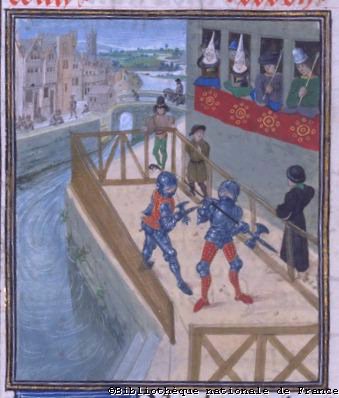
Jousts at Bordeaux with short axes
Regards,
Hugh
www.schlachtschule.org
|
|
    |
 |
Randall Moffett

|
 Posted: Wed 15 Aug, 2007 2:19 am Post subject: Posted: Wed 15 Aug, 2007 2:19 am Post subject: |
 |
|
Hugh,
I had not thought about giving the head grip. That does seem to make sense. Especially as you mentioned that some have the small waffle faces on them.
I have seen the connection where they are integral langets as well but it seems sperate ones are more common from the ones I have seen. Thanks for the picture. I think I had seen it long ago but looking at it now that is exactly perfect for an answer.
Here is a close of of two poleaxes we have and an interesting halbard. Sorry the pictures are so bad. Not sure what happened. If anyone is ever in York it is worth going into the Castle Museum by the way. They have tons of pole weapons from 15th onwards! I am not up there right now but I have taken a few people to see some of the cool stuff before, some Armoury friends included. A very nice store for early modern stuff.
RPM
 Attachment: 113.89 KB Attachment: 113.89 KB
[ Download ]
 Attachment: 102.79 KB Attachment: 102.79 KB
[ Download ]
 Attachment: 98.2 KB Attachment: 98.2 KB
[ Download ]
|
|
  |
 |
|
Hugh Knight
|
 Posted: Wed 15 Aug, 2007 3:21 am Post subject: Posted: Wed 15 Aug, 2007 3:21 am Post subject: |
 |
|
| Randall Moffett wrote: | | I had not thought about giving the head grip. That does seem to make sense. Especially as you mentioned that some have the small waffle faces on them. |
Exactly. Here's a picture of one where you can really see the waffle points:
http://www.myArmoury.com/view.html?features/p...eaxe21.jpg
| Quote: | | I have seen the connection where they are integral langets as well but it seems sperate ones are more common from the ones I have seen. Thanks for the picture. I think I had seen it long ago but looking at it now that is exactly perfect for an answer. |
You're very welcome.
| Quote: | | Here is a close of of two poleaxes we have and an interesting halbard. Sorry the pictures are so bad. Not sure what happened. |
Thank you very much for the pictures! That looks like a neat collection.
By the way, have you compared the weapon in the first picture with this one:
http://www.myArmoury.com/view.html?features/p...eaxe05.jpg
There's a lot of fascinating similarities there; I'd have guessed yours was 16th century, too.
Regards,
Hugh
www.schlachtschule.org
|
|
    |
 |
|
Oliver Wiegand
Location: Germany Joined: 07 Aug 2007
Posts: 22
|
|
  |
 |
|
|

